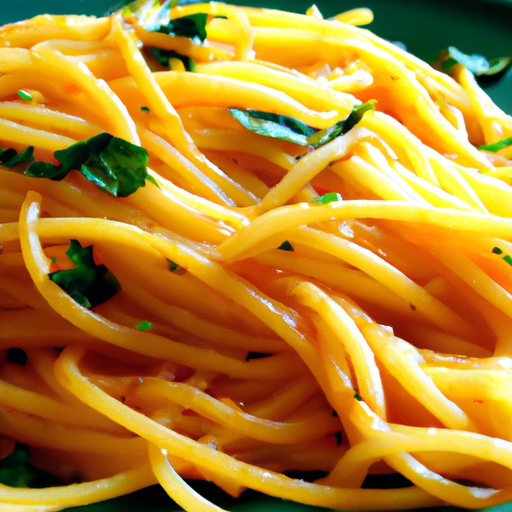Cooked Bucatini Pasta: A Delightful Italian Dish!
Pasta lovers, rejoice! Today, we’re diving into the wonderful world of bucatini pasta. With its unique shape and versatile nature, cooked bucatini is a favorite among Italian cuisine enthusiasts. Whether you enjoy it with a simple tomato sauce or use it in more complex recipes, this pasta never fails to impress. So, let’s uncover the delicious flavors, cooking techniques, nutritional benefits, and captivating history behind this beloved Italian delicacy.
Taste and Texture
Bucatini pasta is similar in shape to traditional spaghetti but has a hollow center, resembling a thin tube. This distinct feature is what sets it apart, providing a delightful eating experience. When cooked to perfection, bucatini pasta has a satisfying al dente bite, offering a balance between tenderness and firmness.
In terms of flavor, bucatini has a mild, wheaty taste that pairs well with a wide range of sauces and ingredients. Its tubular shape acts as a perfect vessel to trap and hold sauces, allowing for a burst of flavors with every bite.
Common Uses in Cooking
Bucatini pasta is a versatile ingredient that can be paired with a variety of sauces, meats, and vegetables. Traditional Italian recipes often feature bucatini with robust tomato-based sauces, such as Amatriciana or Carbonara. The hollow center of the pasta helps to hold the sauce, resulting in a delightful explosion of flavors in every mouthful.
Additionally, bucatini works beautifully with chunky meat ragù sauces or creamy cheese-based sauces. Its unique shape captures and holds onto the sauce, creating a perfect balance of textures and tastes.
For a lighter option, bucatini can be tossed with olive oil, garlic, chili flakes, and topped with fresh herbs and grated cheese. This simple yet flavorful combination allows the pasta to shine without overpowering flavors. Bucatini also serves as a fantastic base for cold pasta salads, incorporating a new twist into traditional recipes.
Nutritional Value
When it comes to nutritional value, bucatini pasta provides a satisfying and energizing meal. Here’s a breakdown of its key nutritional components:
- Carbohydrates: Bucatini is primarily made from durum wheat semolina, providing a good source of complex carbohydrates for sustained energy.
- Fiber: The hollow center of bucatini pasta contributes to its higher fiber content compared to other pasta shapes. Fiber aids digestion and promotes a feeling of fullness.
- Protein: While not as protein-rich as legumes or meat, bucatini pasta still contributes a small amount of protein to your meal.
- Vitamins and Minerals: Bucatini contains essential vitamins and minerals like iron, selenium, and B vitamins, albeit in smaller quantities compared to whole grains or vegetables.
As with most foods, portion control is key to harnessing the nutritional benefits of bucatini pasta while maintaining a well-balanced diet.
History and Fascinating Facts
Bucatini pasta has a rich, centuries-old history deeply rooted in Italian culinary traditions. It is said to have originated in the Lazio region of central Italy, particularly in Rome. The term “bucatini” comes from the Italian word “buco,” meaning “hole” or “opening.”
Legend has it that bucatini pasta was created to mimic the straw used by local shepherds at the time. The hollow center allowed the pasta to be cooked faster, ensuring a quick meal for the busy shepherds.
Interestingly, bucatini is also a staple in the city of Amatrice, which boasts one of Italy’s most famous sauces - Amatriciana. This delicious sauce, made with guanciale (cured pork cheek), tomatoes, pecorino cheese, and chili flakes, complements bucatini perfectly.
Today, bucatini pasta remains beloved by Italians and food enthusiasts worldwide. Its unique shape and ability to hold sauces make it a favorite for creating memorable and flavorful dishes.
Get Cooking with Bucatini!
Now that you’ve discovered the wonders of bucatini pasta, it’s time to head to your kitchen and start experimenting with this versatile ingredient. Whether you’re in the mood for a classic Italian dish or want to put your own twist on a recipe, bucatini is sure to inspire your culinary creativity.
Remember to cook the pasta until it reaches the perfect al dente texture and pair it with your favorite sauce or ingredients. Let the hollow center of bucatini captivate your taste buds as you savor each mouthful. Buon appetito!
Note: Bucatini pasta can typically be found in Italian specialty stores or well-stocked supermarkets. If unavailable, you can substitute it with spaghetti or another long, thick pasta.
Cooked Bucatini Pasta
Origin:
- Bucatini pasta originated in Italy. It is a type of pasta that belongs to the family of long, hollow, and cylindrical pasta shapes. It is particularly popular in central Italy, specifically in the regions of Lazio and Campania.
Common Uses:
- Bucatini is commonly used in traditional Italian dishes such as Bucatini all’Amatriciana and Bucatini alla Carbonara. These dry sauces with strong flavors perfectly cling to the hollow center of the pasta, providing a delightful eating experience.
Nutritional Benefits:
- Bucatini pasta is primarily made from durum wheat semolina, which contains protein and carbohydrates. It is also a good source of iron, selenium, and B vitamins. However, its nutritional content can vary depending on the brand and any additional ingredients added to the pasta.
Unique Properties:
- Bucatini is known for its unique shape with a hollow center, resembling thick spaghetti with a long hole running through its center. This hollow core allows the pasta to hold onto sauce, making it an ideal choice for flavorful and robust sauces.
Historical Significance:
- The name “bucatini” is derived from the Italian word “buco,” meaning “hole.” It is believed that bucatini pasta has been consumed in Italy since ancient times. The pasta’s shape and texture have remained relatively unchanged over the centuries, maintaining its traditional significance in Italian cuisine.




Use the share button below if you liked it.
It makes me smile, when I see it.